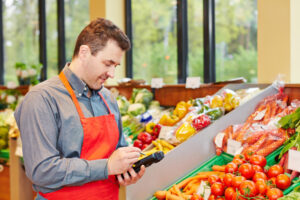Overview
- Food and beverage companies face inventory challenges from public scrutiny over food safety and granular government oversight.
- Mobile barcoding technology equips these companies with real-time visibility and traceability to mitigate these challenges.
- Offline mobility solutions enable continuous availability data collection, even in freezers or out in the field.

Food habits are changing. From the rising popularity of “meatless” products to an increased focus on sustainable packaging, consumers continue to drive trends throughout the food and beverage industry.
What hasn’t changed is the continued public concern over food safety. 56% of surveyed Americans are more concerned about food safety than they were in prior years. With sanitization and human safety now even more on the minds of consumers, these statistics are set to remain firm, if not increase.
This public concern directly drives increasingly strict food safety regulations and controls. Non-compliance to regulatory requirements, such as the ability to respond to a recall rapidly and accurately, can lead to devastating consequences.
To meet these challenges—and emerging challenges of tomorrow—companies operating in food and beverage must improve inventory visibility by turning to automation technology like mobile barcoding or risk getting left behind.
The Problem: Tracking Inventory Across the Food & Beverage Supply Chain
Using outdated methods to track inventory across your warehouse, production, or supply chain keeps your team in the dark about crucial information such as inventory location, quantity, expiration date (of each ingredient) and receiving date. This lack of insight makes it all but impossible to scale inventory processes or trace contaminated or recalled materials with any degree of agility. It also makes it more challenging to meet customer demand.
Food and beverage companies have historically relied on manual data collection methods such as paper-based recording and spreadsheets, keying handwritten data into a computer workstation or relying on memory or “tribal” knowledge. However, this approach leads to misinformation, lost inventory, and manual recounts, all of which are costly and inefficient for supply chain management.
Inevitable human error and a lack of timely data frustrates team members and reduces inventory visibility, which can be catastrophic in the event of a food or ingredient recall.
Watch a short success story video about this food & beverage plant food pioneer »
Compliance to Federal Regulations and Food Safety Standards
Adhering to strict federal regulations for food product and ingredient traceability remains one of the most consistent challenges across the food and beverage industry. In the event of a regulatory audit or recall, food and beverage manufacturers and distributors must have a plan in place to trace compromised ingredients and products and contain the potential fallout.
However, manual data collection and paper-based recording processes make a timely response nearly impossible, significantly increasing the risk of regulatory infractions and harmful public exposure.
Often, this means the only course of action is to destroy the good product with the bad, as companies lack the track-and-trace food traceability software needed to identify compromised items throughout supply chain management processes. While this option may reduce civil and criminal litigation, it has serious effects on a company’s bottom line. It is also not a long-term solution.
Read More: The Food Traceability Survival Guide »
Remote, Offline and Limited Connections

Many food and beverage businesses must also operate in offline and remote areas lacking reliable infrastructure, such as in field service delivery or in areas with limited connectivity.
These challenging scenarios make it more difficult to maintain consistent and reliable connections with your ERP, so historically many companies have relied on paper-based recording. However, this can result in inconsistent inventory counts, a lack of timeliness, and even lost or unaccounted for product.
The Solution: Modernizing with Real-time Inventory
Embracing technologies to solve these challenges and achieve real-time inventory visibility and control across the supply chain is now a top priority for forward-thinking food and beverage producers.
One such technology is mobile barcoding.
Mobile Barcoding and Inventory Management
Built on food and beverage supply chain best practices, mobile barcoding extends the ERP system onto mobile devices with pre-built mobile apps to automate previously manual processes. By updating inventory for both inbound and outbound processes as work occurs and without error, operations can maximize accuracy and visibility.
Now, businesses can easily track raw materials, food ingredients, and end products through every stage of harvesting, production and distribution. In the event of a recall or audit, you can quickly and easily locate the affected products by ingredient, lot, supplier, grocery store and more. The ability to pull only the affected items from the supply chain helps mitigate losses.
Enhanced Traceability to Ensure Compliance
Mobile barcoding and traceability software prevent errors associated with manual data entry to boost accuracy up to 99.99%, creating the visibility to satisfy regulatory requirements. This equips food and beverage companies with the food traceability software needed to pull and destroy only affected products during a recall, avoid civil and criminal action and retain consumer trust.
Using mobile barcoding technology with handheld scanners, transactions automatically create traceability paths in your system of record. If you need to respond to an audit or trace a recalled item, the movements or location of the items, even by ingredient, can be found in minutes. Finding the same information in a paper-based system could take weeks or months—if they are located at all.
Also Read: Why Traceability Matters More Than Ever »
Capturing Data, Regardless of Connectivity
Solutions for offline mobility enable workers to continue collecting data even when network or ERP connectivity is temporarily unavailable or limited.
Offline mobility can also help solve the challenges associated with field delivery or field services by enabling users to capture data and then transact once connectivity is restored or during predetermined timed updates.
Continuous availability and offline batch solutions enable you to collect data in areas of your warehouse that network connections can’t reach, like a walk-in freezer. When the connectivity is restored, the offline transactions are queued to update the ERP.
ALSO READ: 3 Ways to Prevent Lost Inventory with Track and Trace Software »
Improve inventory visibility, meet customer demand
Your warehouse management systems need to keep up with the current demands of inventory management and customer satisfaction. This requires food traceability software for more effective supply chain management and real-time inventory visibility.
Whether your operations are struggling to meet FDA food traceability requirements or simply need the benefits of inventory visibility to meet increased levels of customer satisfaction, food traceability software such as mobile barcoding and data collection can be the solution for future success.






